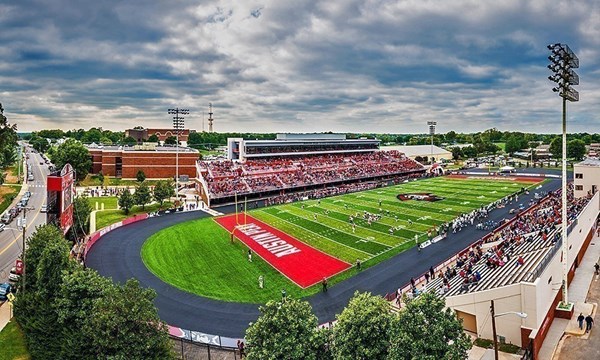Scotty Walden Football Camps
Fortera Stadium
 In April 2016, Austin Peay State University and Fortera Credit Union partnered to rename historic Governors Stadium as Fortera Stadium.
In April 2016, Austin Peay State University and Fortera Credit Union partnered to rename historic Governors Stadium as Fortera Stadium.
Ushering in a new era at Austin Peay, the University and Fortera Credit Union entered a 25-year, $2.5 million sponsorship agreement with the dual purpose of expanding the Fortera brand in Clarksville and providing Austin Peay athletics with resources to enhance facilities within the department.
It's another step in a series of updates for one of Austin Peay's most iconic facilities.
Fortera Stadium re-opened in 2014 following the completion of a massive $16.9 million renovation that replaced the west side grandstands with a new structure that includes state-of-the-art amenities for student-athletes, coaches and fans as well as skyboxes, club-type seating and new chairback seating.
The first floor of the new facility includes the Bill Dupes Locker Room, the new home for the Governors football team. Football student-athletes also have access to new athletic training facilities and their gear is stowed in a new equipment room. In addition, fans can purchase their game day tickets at the football ticket offices with windows located in the center of the facility.
Fans are able to access the main grandstand from the second level. That area also includes new concession stands and is the home of the GovsGear.com store which provides fans the opportunity to purchase the latest in Austin Peay athletics apparel every game day.
The third and fourth levels provide club seating and 13 skyboxes, respectively. The skyboxes offer tiered stadium-type seating with up to 22 seats. The 8,000-square-foot Echo Power Club Level seats 386 spectators and is designed to offer catered meals on football game days.
To the south of the new stadium facility is the Blake Jenkins Plaza, which provides an expansive concourse for fans to enter the facility. In addition, the Hendricks Fox Walk of History is located in this area and features the name of every football player to have donned the Governors uniform.
In a separate project, the stadium's east grandstands, while not razed, were renovated to move the stadium's in-game operations into the press box. In addition, space under the east grandstand was renovated for the university's track and field program.
Recent additions to the team facilities at Fortera Stadium include a strength and conditioning facility as well as nutrition room that opened prior to the start of the historic 2017 season. Austin Peay's sports medicine unit opened its state-of-the-art athlete care facility inside the first floor of Fortera Stadium prior to the 2018 campaign.
Austin Peay has played football on the corner of Marion and Henry streets since 1946. The facility originally was named Municipal Stadium when it opened in 1946 due to its construction by the City of Clarksville. The city owned and operated the facility while permitting the University use of the stadium for an annual sum. That arrangement lasted until 1970 when the city conveyed title to one-third of the stadium to the State for the university and signed a cooperative agreement with Austin Peay State University, Montgomery County (to which it also gave one-third of the stadium's title) and the city to form the Municipal Stadium Authority to operate and maintain the facility.
Following the 1993 season, the University agreed to purchase Municipal Stadium from the Stadium Authority and Montgomery County. With the purchase, the University installed a new artificial playing surface and, more importantly, changed the name of the facility to Governors Stadium.
From 1993 until the 2016 construction of Fortera Stadium, the University made several updates to the facility, replacing the playing surface in 1993, 2004 and in 2014 while adding a new scoreboard and video board combination on the stadium's south end in 2007.
However, the greatest transformation to the facility since its 1946 construction was approved in 2012 when the Tennessee Building Commission approved a $16 million renovation project, which ushered in the newest era of Governors football.
